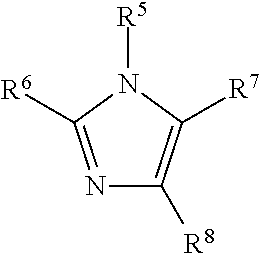Method for forming coating film and coated article
a coating film and coating composition technology, applied in the field of multi-layer coating film formation, can solve the problems of unsatisfactory art, difficult to satisfy the requirement of excellent appearance in automobile body coating and other kinds of coating, and the method of forming a coating film using such a coating composition has been unsatisfactory in curability, etc., to achieve satisfactory pot life, short period of time, excellent curability
- Summary
- Abstract
- Description
- Claims
- Application Information
AI Technical Summary
Benefits of technology
Problems solved by technology
Method used
Image
Examples
examples
[0204]The present invention is described in more detail below with reference to Examples and Comparative Examples. However, the present invention is not limited to the following Examples. Also, in the following Examples, “part(s)” and “%” are based on mass, and the film thicknesses of coating films are based on the cured coating films.
Production of Hydroxy-Containing Acrylic Resin
production examples 1 to 12
[0205]In each Example, 31 parts of ethoxyethyl propionate was placed into a four-necked flask equipped with a stirrer, a thermometer, a condenser tube, and a nitrogen gas inlet, and heated to 155° C. under a nitrogen gas stream. After the temperature reached 155° C., the nitrogen gas stream was stopped, and a monomer mixture of the monomers and the polymerization initiator at the proportions shown in Table 1 below was added dropwise thereto over a period of 4 hours. Subsequently, aging was carried out at 155° C. for 2 hours under a nitrogen gas stream. The resulting product was then cooled to 100° C. and diluted with 32.5 parts (7.5 parts in only Production Example 10) of butyl acetate. Thereby, hydroxy-containing acrylic resins (A−1) to (A-12) having a solids content of 60% were obtained. Table 1 below shows the mass solids concentration (%) and resin properties of each of the obtained hydroxy-containing acrylic resins.
[0206]The glass transition temperature (° C.) values listed in ...
production example 13
[0209]47 parts of ethyl-3-ethoxypropionate and 81.6 parts of Nikka Octhix Zinc (*1) (zinc octylate, produced by Nihon Kagaku Sangyo Co., Ltd., zinc content: 8% by mass) were placed into a reactor equipped with a stirrer, a condenser, a temperature controller, a nitrogen inlet tube, and a dropping funnel. The air in the reactor was replaced with nitrogen, and the mixture was heated to 50° C. Subsequently, 16.4 parts of 1-methylimidazole was added dropwise thereto while being stirred. After completion of the dropwise addition, the 50° C. temperature was maintained for 2 hours, and the reaction was terminated. The obtained organometallic catalyst (C-1) was a transparent liquid having a zinc content of 4.5% by mass.
PUM
| Property | Measurement | Unit |
|---|---|---|
| Temperature | aaaaa | aaaaa |
| Percent by mass | aaaaa | aaaaa |
| Percent by mass | aaaaa | aaaaa |
Abstract
Description
Claims
Application Information
 Login to View More
Login to View More - R&D
- Intellectual Property
- Life Sciences
- Materials
- Tech Scout
- Unparalleled Data Quality
- Higher Quality Content
- 60% Fewer Hallucinations
Browse by: Latest US Patents, China's latest patents, Technical Efficacy Thesaurus, Application Domain, Technology Topic, Popular Technical Reports.
© 2025 PatSnap. All rights reserved.Legal|Privacy policy|Modern Slavery Act Transparency Statement|Sitemap|About US| Contact US: help@patsnap.com

